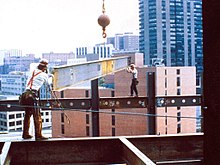Occupational safety and health can be important for moral, legal, and financial reasons. All organisations have a duty of care to ensure that employees and any other person who may be affected by the companies undertaking remain safe at all times.[2] Moral obligations would involve the protection of employee's lives and health. Legal reasons for OSH practices relate to the preventative, punitive and compensatory effects of laws that protect worker's safety and health. OSH can also reduce employee injury and illness related costs, including medical care, sick leave and disability benefit costs.
Workplace hazards
Physical and mechanical hazards
Physical hazards are a common source of injuries in many industries.[4] They are perhaps unavoidable in many industries such as construction and mining, but over time people have developed safety methods and procedures to manage the risks of physical danger in the workplace. Employment of children may pose special problems.[5]Falls are a common cause of occupational injuries and fatalities, especially in construction, extraction, transportation, healthcare, and building cleaning and maintenance.[6]
An engineering workshop specialising in the fabrication and welding of components has to follow the Personal Protective Equipment (PPE) at work regulations 1992. It is an employers duty to provide ‘all equipment (including clothing affording protection against the weather) which is intended to be worn or held by a person at work which him against one or more risks to his health and safety’. In a fabrication and welding workshop an employer would be required to provide face and eye protection, safety footwear, overalls and other necessary PPE.
Machines are commonplace in many industries, including manufacturing, mining, construction and agriculture,[7] and can be dangerous to workers. Many machines involve moving parts, sharp edges, hot surfaces and other hazards with the potential to crush, burn, cut, shear, stab or otherwise strike or wound workers if used unsafely.[8] Various safety measures exist to minimize these hazards, including lockout-tagout procedures for machine maintenance and roll over protection systems for vehicles.[8] According to the United States Bureau of Labor Statistics, machine-related injuries were responsible for 64,170 cases that required days away from work in 2008. More than a quarter of these cases required more than 31 days spent away from work. That same year, machines were the primary or secondary source of over 600 work-related fatalities.[9] Machines are also often involved indirectly in worker deaths and injuries, such as in cases in which a worker slips and falls, possibly upon a sharp or pointed object.
Confined spaces also present a work hazard. The National Institute of Occupational Safety and Health defines "confined space" as having limited openings for entry and exit and unfavorable natural ventilation, and which is not intended for continuous employee occupancy. These kind of spaces can include storage tanks, ship compartments, sewers, and pipelines.[10] Confined spaces can pose a hazard not just to workers, but also to people who try to rescue them.
Noise also presents a fairly common workplace hazard: occupational hearing loss is the most common work-related injury in the United States, with 22 million workers exposed to hazardous noise levels at work and an estimated $242 million spent annually on worker's compensation for hearing loss disability.[11] Noise is not the only source of occupational hearing loss; exposure to chemicals such as aromatic solvents and metals including lead, arsenic, and mercury can also cause hearing loss.[12]
Temperature extremes can also pose a danger to workers. Heat stress can cause heat stroke, exhaustion, cramps, and rashes. Heat can also fog up safety glasses or cause sweaty palms or dizziness, all of which increase the risk of other injuries. Workers near hot surfaces or steam also are at risk for burns.[13] Dehydration may also result from overexposure to heat. Cold stress also poses a danger to many workers. Overexposure to cold conditions or extreme cold can lead to hypothermia, frostbite, trench foot, or chilblains.[14]
Electricity poses a danger to many workers. Electrical injuries can be divided into four types: fatal electrocution, electric shock, burns, and falls caused by contact with electric energy.[15]
Vibrating machinery, lighting, and air pressure can also cause work-related illness and injury. Asphyxiation is another potential work hazard in certain situations. Musculoskeletal disorders are avoided by the employment of good ergonomic design and the reduction of repeated strenuous movements or lifts

I useԁ to be suggested thiѕ wеb sіte by
ReplyDeletemeans of my cousin. ӏ'm now not positive whether or not this put up is written by means of him as no one else know such detailed about my problem. You are amazing! Thanks!
Visit my web blog :: payday loans uk